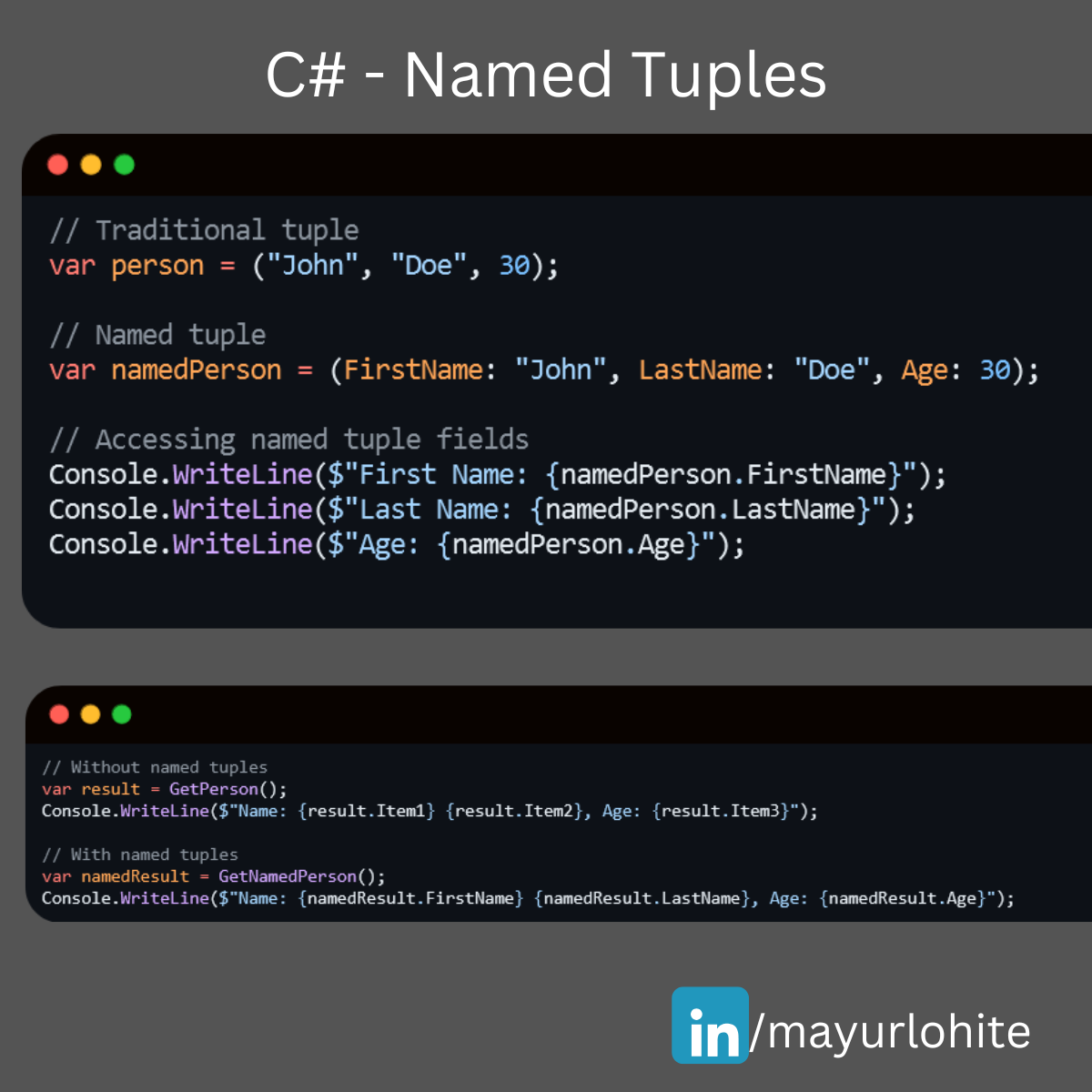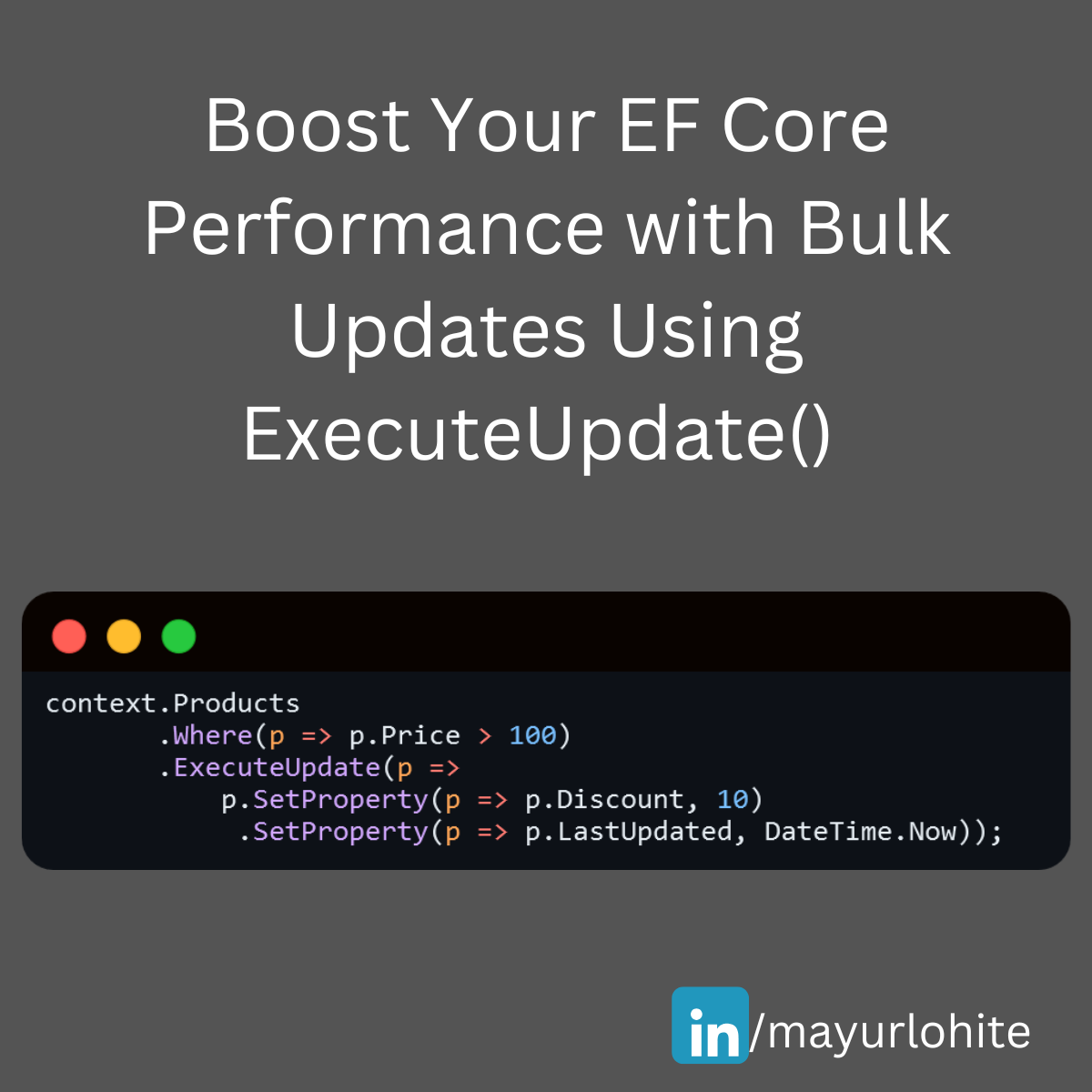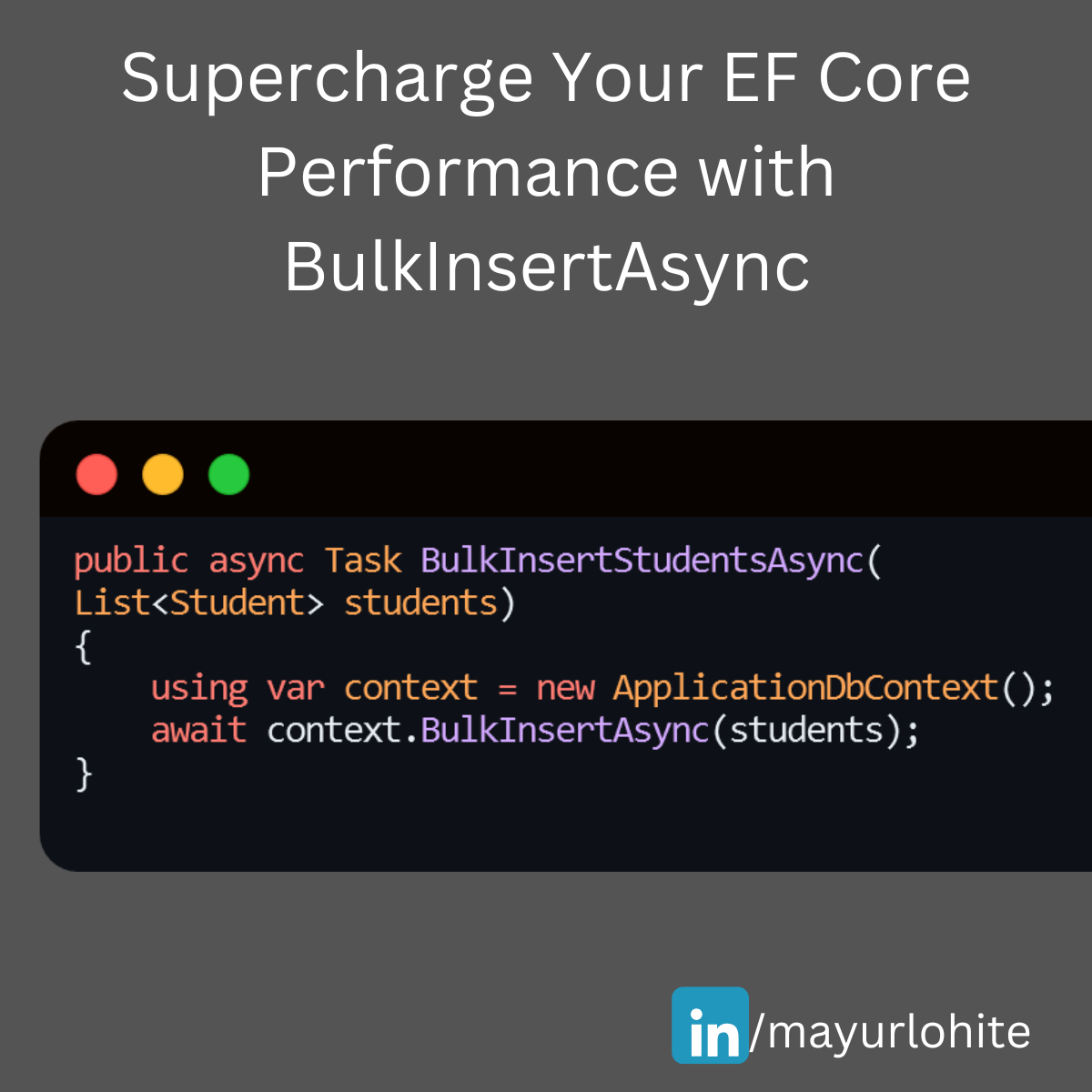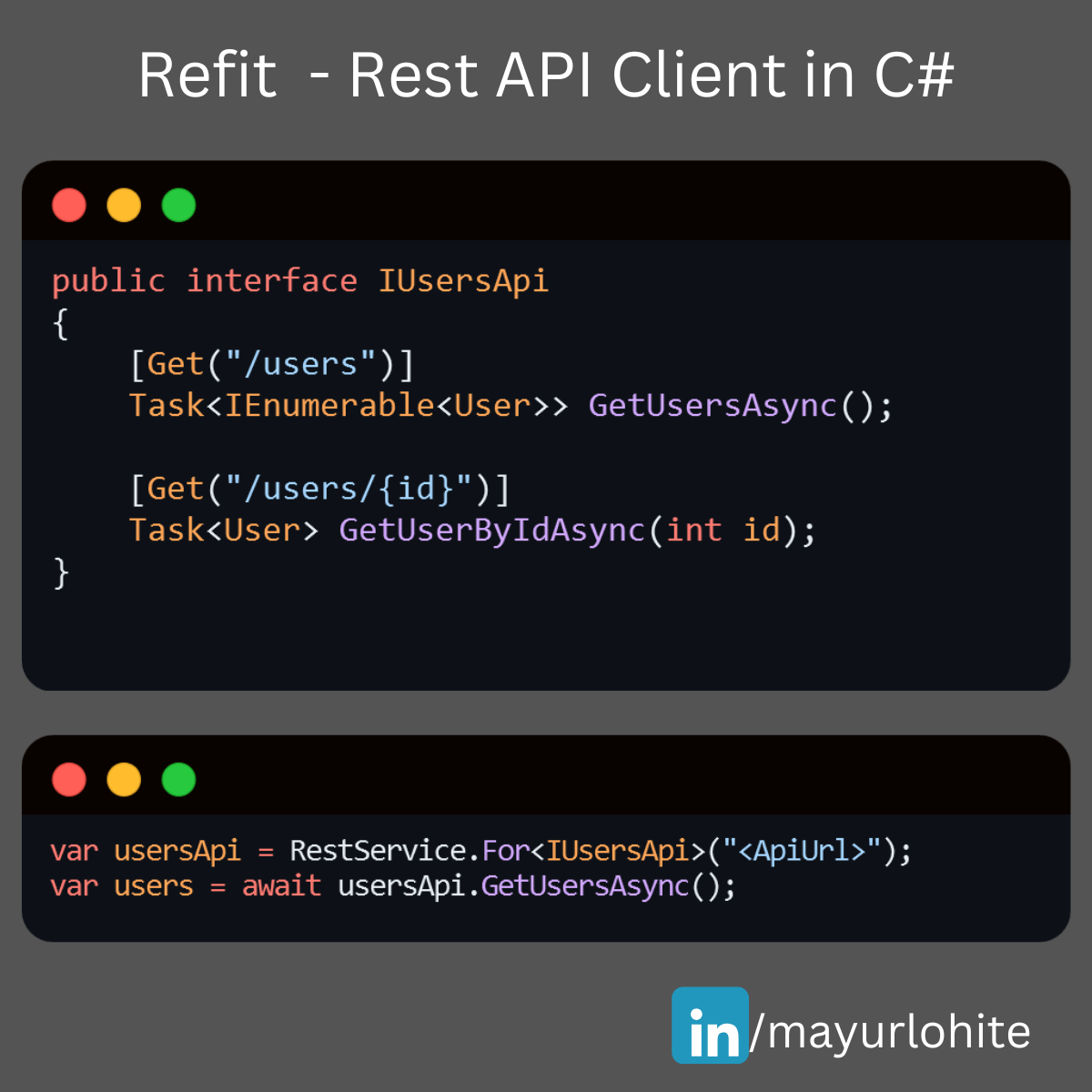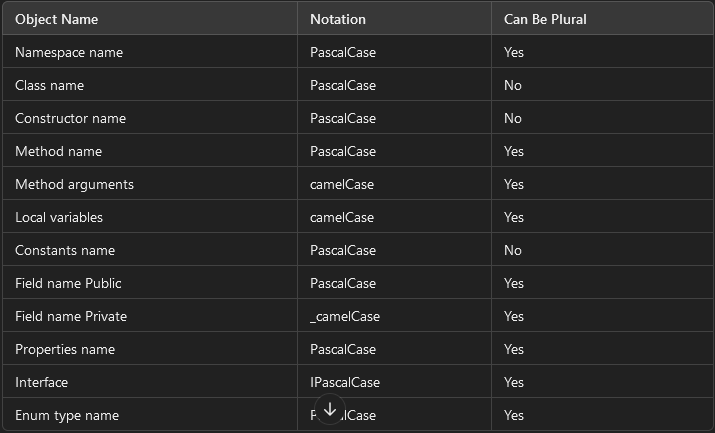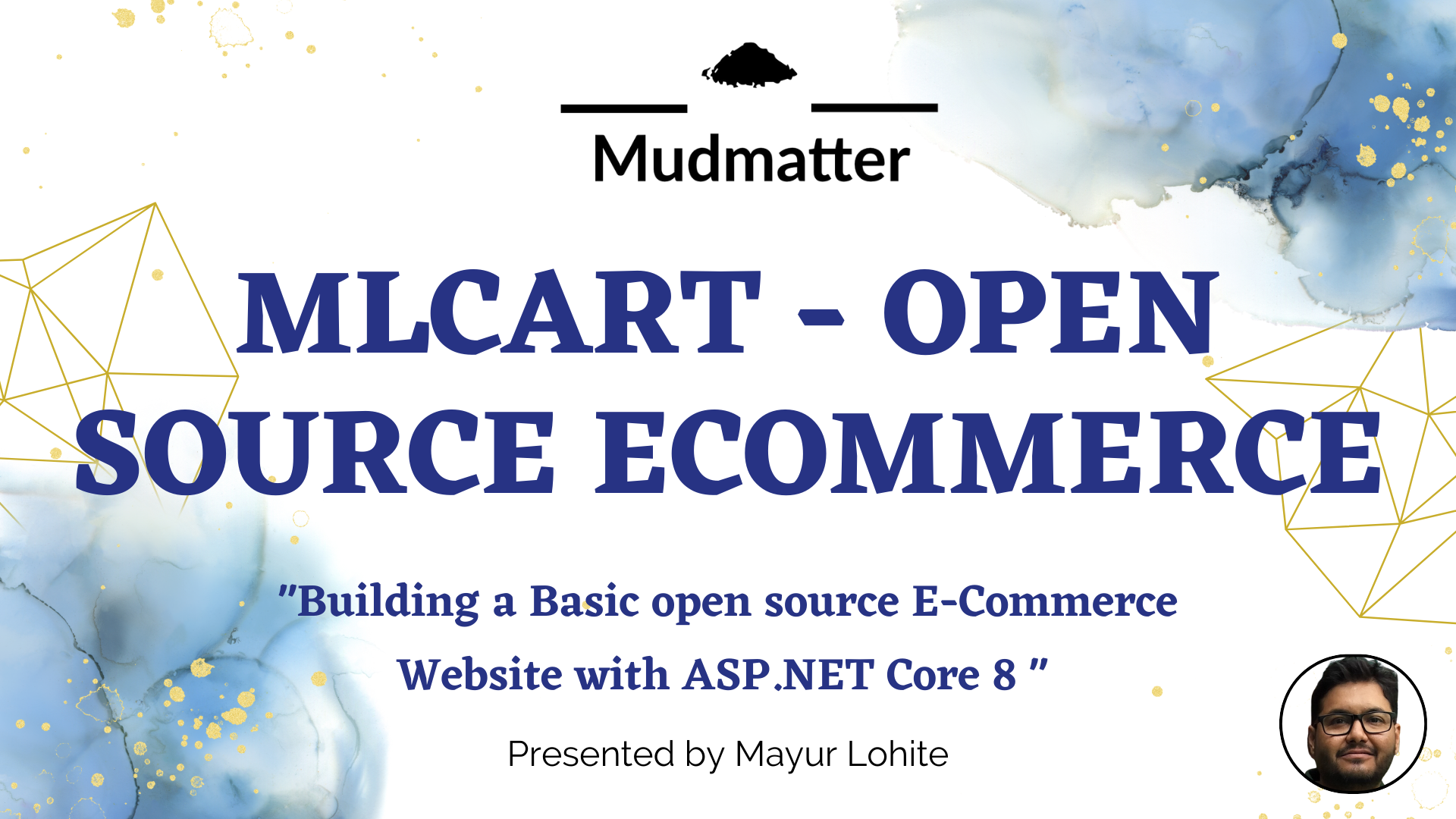How to Prevent Spam in Contact Forms with .NET Core 8.0 MVC – A Step-by-Step Guide
Dealing with spam submissions in your lead or contact forms can be incredibly frustrating—especially when you’ve already implemented CAPTCHA and other spam prevention measures. But what if I told you there's a simple yet effective solution that could help you significantly reduce unwanted form submissions?
In this post, I’ll walk you through a quick tip for blocking spam in your forms using .NET Core 8.0 MVC. While this solution is tailored to .NET Core, the logic can be adapted to other technologies as well, making it versatile and easy to implement across different platforms.
Why Spam Forms Are a Problem
Spammers often use automated bots or scripts to find and submit contact or lead forms on websites, flooding your inbox with irrelevant, sometimes harmful, content. CAPTCHA (Completely Automated Public Turing test to tell Computers and Humans Apart) has been a popular solution for this, but it’s not foolproof. Bots are becoming smarter and can sometimes bypass CAPTCHA mechanisms.
Luckily, there’s a much simpler method to keep spammers out while ensuring legitimate visitors can still submit forms without a hitch.
The Simple Trick: Adding a Hidden Field
The solution? A hidden input field. It’s a basic technique that prevents bots from submitting forms, as they typically “fill out” all fields, including hidden ones. By checking if this field is empty when the form is submitted, you can easily determine whether it was filled out by a bot or a human.
Let’s take a look at how to implement this in a .NET Core 8.0 MVC application.
Step 1: Build the Contact Form
Here’s a basic contact or lead form that users can fill out. This example uses .NET Core MVC syntax:
<form asp-action="contact" asp-controller="home" method="post">
<input class="form-control" type="text" maxlength="255" asp-for="FullName" placeholder="Your Name" required>
<input class="form-control" type="email" maxlength="255" asp-for="Email" placeholder="Your Email" required>
<input class="form-control" type="text" pattern="^[0-9]*$" maxlength="15" asp-for="Phone" placeholder="Your Phone with Country Code">
<textarea class="form-control" asp-for="Message" cols="40" rows="5" maxlength="1000" placeholder="Your Message" required></textarea>
</form>
Now, let’s add a hidden field to this form:
<input class="additional-note" type="text" style="display:none;">
Step 2: Implement the Spam Check Logic
When the form is submitted, we check whether the hidden field is filled out. If it’s empty, the submission is likely from a human. If it's not, it’s probably a bot, and we can discard the submission.
In the controller, add the logic to handle this check:
[HttpPost("contact")]
[ValidateReCaptcha]
public async Task<IActionResult> Contact(LeadModel model)
{
if (!ModelState.IsValid)
return View();
try
{
bool result = await _contactService.SaveLead(model);
TempData["success"] = result ? "We have received your request, and we'll get back to you shortly!" : "Sorry, we couldn't process your request.";
return RedirectToAction("contact", "home");
}
catch (Exception ex)
{
TempData["fail"] = "Sorry! Something went wrong while processing your request.";
_logger.LogError(ex, $"Error occurred while saving lead - {Helper.Dump(model)}");
}
return View();
}
Step 3: Business Logic Service
In the business logic service, we need to ensure that the lead is saved only if the hidden field is empty (indicating it wasn’t filled out by a bot):
public async Task<bool> SaveLead(LeadModel? leadModel)
{
if (leadModel == null || !string.IsNullOrWhiteSpace(leadModel.RepeatLead))
return false; // Discard leads where the hidden field is filled out (likely spam).
var lead = _mapper.Map<Lead>(leadModel);
return await _contactRepository.SaveLead(lead);
}
How It Works:
Bots vs Humans: Bots usually fill out all fields, including hidden ones, whereas humans won’t interact with hidden fields.
Quick Spam Detection: If the hidden field is filled out, we treat the submission as spam and reject it.
Seamless User Experience: Legitimate users can still submit the form as usual without any interruption.
Why This Works
Spammers use automated scripts to find and submit forms, but they don’t know about hidden fields that are intentionally left blank. This simple trick helps filter out spam without adding extra layers of complexity or affecting user experience. Plus, it’s incredibly easy to implement with .NET Core MVC.
Conclusion: A Simple Yet Effective Spam Prevention Solution
Implementing a hidden field in your forms is a quick and effective way to fight spam without over-complicating things. This approach works across various technologies, so feel free to adapt it to your tech stack.
By using this method, you can keep your contact forms clean and only receive genuine submissions. 💪
What Do You Think?
Have you tried similar techniques to block spam in your forms? What methods have worked best for you? Share your thoughts in the comments below!
Also, feel free to share this post with anyone who might benefit from a spam-free experience on their website. Let’s keep our forms secure and user-friendly!
🚀 C#/.NET Tip - Const vs Readonly 💡
💎 Understanding the Difference Between const and readonly in C#
🔹 Const:
Constants are static by default.
They must be assigned a value at compile-time.
Can be declared within functions.
Each assembly using them gets its own copy of the value.
Can be used in attributes.
🔹 Readonly:
Must be assigned a value by the time the constructor exits.
Evaluated when the instance is created.
Static readonly fields are evaluated when the class is first referenced.
Example:
public class MathConstants
{
public const double Pi = 3.14159;
public readonly double GoldenRatio;
public MathConstants()
{
GoldenRatio = (1 + Math.Sqrt(5)) / 2;
}
}
Explanation:
Pi is a const and its value is fixed at compile-time. It cannot be changed and is the same across all instances.
2. GoldenRatio is a readonly field, which is calculated at runtime when an instance of MathConstants is created. This allows for more flexibility as the value can be set in the constructor.
This example highlights how const is used for values that are truly constant and known at compile-time, while readonly is used for values that are determined at runtime but should not change after being set.
I hope this helps! 😊
The open positions as of today 07 Feb 2025 are (How to apply is mentioned below):
Client: Infosys
Position Name: Oracle OAF
Experience: 5 years
Location: Remote
Rate: Contact for rate and payment terms
Position Name: Oracle E-Business Suite ERP Developer
Experience: 5 years
Skills Required: Minimum 5 years of role experience as Oracle EBS Techno Functional consultant. Experience in designing and developing financial solutions on Oracle eBusiness Suite R12 platform, with focus on Procure to Pay (P2P), Record to Report (R2R), and AR modules and global rollouts. Extensive hands-on development and functional experience and proficiency in SQL and PL/SQL, Oracle Workflow, BI publisher, AME, Oracle Forms, Oracle Reports, UNIX Shell scripts, Java, and OA Framework. Experience in system integration and familiarity with enterprise application integration (EAI) technologies. Experience and knowledge of Oracle modules, Apache/IIS, WebLogic application server, and other middleware platforms would be a plus. Experience in SAP Concur and Ariba application would be a plus. Extensive development knowledge of Oracle eBusiness Suite R12 (Account Receivable, Purchasing, Payables, Payments, EBTax, Cash Management, Fixed Assets, General Ledger, Sub ledger Accounting, XML Gateway, System Administration, TCA Architecture) and related systems. Experience in and understanding of the software development lifecycle and methodologies and Finance operations (accounts payable, sourcing, accounting, financial internal controls) business process knowledge in a global setting.
Location: Bangalore
Rate: Contact for rate and payment terms
Position Name: Big Data Engineer with Airflow, Python
Experience: 5+ years
Location: Bengaluru
Rate: Contact for rate and payment terms
Position Name: Oracle E-Business Suite (ERP) Test Engineer
Experience: 5+ years
Skills Required: ERP Software Test Engineer will play a key role to partner with the application Support and Development teams for SAP Ariba, SAP Concur, and Oracle ERP (Oracle eBusiness Suite R12- Purchasing, Accounts Payables, General Ledger, EBTax, Fixed Assets, and Accounts Receivables) and other Finance applications. ERP Software Test Engineer will be performed against global initiatives, enhancements, and day-to-day operational Production defects. Tasks include creation of Test Plans, Test Case Creation, Test Data Creation, Manual Testing, Issue Management Resolution, and Documentation. Ability to comprehend complex Business requirements and technical solutions, mapping into Test Cases, and Test Scripts. Manage defects from identification to completion. Assist to standardize reporting and metrics on deliverables by the QA team, including defect logging and status reporting. ERP Software Test Engineer is expected to create SQL queries against database to troubleshoot, create ad-hoc reporting as needed. Work with limited direction, usually within a complex environment, to drive delivery of solutions and meet service levels. Able to work on multiple projects and initiatives with different/competing timelines and demands.
Location: Remote
Rate: Contact for rate and payment terms
Position Name: Database & Middleware Engineer/Administrator
Experience: 4+ years
Skills Required: Provide administration support for various databases, including MS SQL Server, MySQL, and Postgres, ensuring smooth operation and quick issue resolution. Assist in the support and maintenance of Applications/Middleware and Platforms, including troubleshooting, patching, backups & recovery, and system updates. Regularly perform system maintenance tasks, including provisioning, installing, patching, securing, and auditing databases, middleware, and platforms to ensure optimal performance and compliance.
Location: Remote
Rate: Contact for rate and payment terms
Position Name: Identity and Access Management (IAM) Consultant
Experience: 5+ years
Skills Required: This role will require technical knowledge on automation of application IAM data / Access Control List (ACL) into our IAM Governance tool (setting up automated IAM datafeeds through direct database connectivity, proxy sFTP service, other third-party data aggregator tools, etc.). This role requires a deep understanding of the IAM related risks and the relevant mitigating/compensating IAM controls and policies, including control attestation, control testing, and control artifact validations. This position is specialized in providing the end-to-end IAM life cycle including but not limited to the technical application enrollment into the centralized IAM Governance infrastructure, IAM services (weekly access data load into SailPoint, Access provisioning, access deprovisioning, rogue access remediation, orphaned access remediation, Separation of Duties (SOD) remediation, transfer/mover user access reviews, user access revalidation, non-user account credential rotation governance, etc.). Act as the IAM point of contact for a set of assigned applications and manage the enterprise end-to-end IAM lifecycle for these applications. This role will also require analytic skillsets on big data analytics, dashboarding, database query, etc.
Location: Remote
Rate: Contact for rate and payment terms
Position Name: Data Platform Engineer
Experience: 6+ years
Skills Required: Cloud data platform engineer who designs, builds, and manages data storage and workflows in cloud environments. They ensure that data is secure, accessible, and processed efficiently. Data Platform Management and Optimization - designs, builds, and manages data storage and workflows/compute in cloud environments.
Location: Remote
Rate: Contact for rate and payment terms
Position Name: Java Developer with Spring Boot & Microservices
Experience: Total: 8+ years; Relevant: 5+ years
Skills Required: Experience in the development of production-grade applications and services in Java. Hands-on development experience in Java 8, Spring Boot, Microservices. Good knowledge of Java 8 features - Collections, Generics, Authentication, Rest API, multi-threading.
Location: Bangalore
Rate: Contact for rate and payment terms
Position Name: Oracle XStore
Experience: 10 years with 7 years relevant
Skills Required: Oracle DB, SQL, Core Java, Oracle Xstore Suite, XML
Location: Pune, Chennai
Rate: Contact for rate and payment terms
Position Name: Java Developer with SpringBoot & Microservices
Experience: 6+ years (Relevant Experience)
Location: Chennai
Rate: Contact for rate and payment terms
Position Name: Java Developer with SpringBoot, Microservices, Kafka, SQL
Experience: 6+ years (Relevant Experience)
Location: Chennai, Bangalore, Hyderabad
Rate: Contact for rate and payment terms
Position Name: Scala Developer (pure Scala profile)
Skills Required: Programming Language: They primarily use Scala, a language that combines functional and object-oriented programming paradigms. Responsibilities: Design application architecture, write clean Scala code, debug issues, test applications, optimize performance, collaborate with other developers, and ensure application scalability. Typical Applications: Big data processing, distributed systems, web applications, financial systems requiring high-performance transaction processing.
Location: Pune, Kolkata, Hyderabad
Rate: Contact for rate and payment terms
Position Name: Python Lead
Experience: 8+ years (relevant 7+ years)
Location: Pune, Bangalore
Rate: Contact for rate and payment terms
Client: Cybage
Position Name: Python + DevOps (SRE)
Experience: 4-9 years
Skills Required: Working experience & knowledge in Python along with SRE; familiarity with Jenkins/CloudBuild, Ansible, and Cloud Computing platforms. Familiar working with containerization technologies such as Docker and Kubernetes.
Location: Pune-Hybrid
Rate: Contact for rate and payment terms
Client: QIncline
Position Name: Sr. Automation Test Engineer (Java with Selenium)
Experience: 8-9 years
Location: Bangalore
Rate: Contact for rate and payment terms
Position Name: Oracle BRM
Experience: 5-6 years
Skills Required: Legacy to Target Mapping to BRM (OCS) - Prepaid System BRM Loading Mechanisms and previous experience worked on pin_bulk_loader (CMT Tool). Real-Time Data Loading. Fallout Scenarios: Scenario how to fix in case of Data failure, System Performance Issue, Synchronization Issues, TPS limit or any metrics to be followed based on previous migration experience, Data export method to follow for Reconciliation, Retry Mechanisms, Error Correction Frameworks, Performance Tuning, Backup and Recovery (Restore) DB.
Location: Bangalore/Remote
Rate: Contact for rate and payment terms
I hope this format works better for you! Let me know if you need any further adjustments.
How to apply
I have strong relationships with many staffing companies and will be posting multiple job openings daily. Please sign up to receive daily alerts for new job postings. While we are currently developing an online application process, you can follow the steps below to apply in the meantime:
Visit my LinkedIn profile: Mayur Lohite LinkedIn
Send me a Invite or direct message (DM) with the name of the position you are interested in.
Or post your linkedin link in comment so I will send you invite.
I will connect you with the respective staffing agency.
If LinkedIn didn't worked then just visit our contact page and write position name in first line and send us a message -> Contact Us
Thank you for your interest, and I look forward to helping you find your next career opportunity!
Ever heard of the Zip method in LINQ? It's a powerful tool for merging sequences, and it's something every developer should have in their toolkit. Let's dive into how this method can simplify your coding life, especially with the enhancements introduced in .NET 6.
What is the Zip Method?
The Zip method in LINQ allows you to merge two or more sequences into one. Starting from .NET 6, you can combine up to three collections at once. The resulting sequence will match the length of the shortest collection, ensuring a neat and tidy merge.
Why Use the Zip Method?
Simplifies Code: The Zip method reduces the need for multiple foreach loops, making your code cleaner and more readable.
Customizable Pairing: You can use a result selector to customize how the elements are paired together, giving you flexibility in how you merge your data.
Efficiency: By merging sequences in a single step, you can improve the efficiency of your code.
A Practical Example
Let's look at a simple example using .NET Core:
static void Main()
{
var numbers = new[] { 1, 2, 3 };
var words = new[] { "one", "two", "three" };
var zipped = numbers.Zip(words, (n, w) => $"{n} - {w}");
foreach (var item in zipped)
{
Console.WriteLine(item);
}
}
In this example, we have two arrays: numbers and words. The Zip method combines these arrays into a single sequence where each element is a combination of an element from numbers and an element from words. The result is a sequence of strings like "1 - one", "2 - two", and "3 - three".
Real-world Scenario
Imagine you're working on a project that involves merging data from different sources, like combining sales figures with product names. The Zip method can be your go-to solution. It's like making a perfect masala chai, where each ingredient blends seamlessly to create something wonderful.
Conclusion
The Zip method in LINQ is a versatile and powerful tool that can make your coding tasks easier and more efficient. Whether you're working on a small project or a large-scale application, this method can help you merge sequences with ease.
Feel free to share your thoughts in the comments below. If you found this post useful, follow me for more tech insights and don't hesitate to share this with your network! 🚀
Hey Mudmatter community! 👋
Are you looking to make your C# code more readable and maintainable? Named tuples might be just what you need! They allow you to create lightweight, self-descriptive data structures without the overhead of defining a full class.
What are Named Tuples?
Named tuples in C# provide a way to create a tuple with named fields, making your code more intuitive and easier to understand.
Why Use Named Tuples?
Readability: Named fields make it clear what each value represents.
Convenience: No need to define a separate class or struct for simple data grouping.
Immutability: Tuples are immutable by default, ensuring data integrity.
Example - Traditional
// Traditional tuple
var person = ("John", "Doe", 30);
// Named tuple
var namedPerson = (FirstName: "John", LastName: "Doe", Age: 30);
// Accessing named tuple fields
Console.WriteLine($"First Name: {namedPerson.FirstName}");
Console.WriteLine($"Last Name: {namedPerson.LastName}");
Console.WriteLine($"Age: {namedPerson.Age}");
Benefits in Action, Improved Code Clarity:
// Without named tuples
var result = GetPerson();
Console.WriteLine($"Name: {result.Item1} {result.Item2}, Age: {result.Item3}");
// With named tuples
var namedResult = GetNamedPerson();
Console.WriteLine($"Name: {namedResult.FirstName} {namedResult.LastName}, Age: {namedResult.Age}");
//Simplified Data Handling:
// Method returning a named tuple
(string FirstName, string LastName, int Age) GetNamedPerson()
{
return ("John", "Doe", 30);
}
Named tuples are a fantastic feature to enhance your C# projects. Give them a try and see how they can simplify your code!
Happy coding! 💻✨
🚀 Exciting News for EF Core Users! 🚀
The latest version of Entity Framework Core (EF Core 7) introduces a powerful new feature: Bulk Update! This feature significantly enhances performance when updating multiple records in your database. Let's dive into how it works and see a sample in action.
What is Bulk Update?
Bulk Update allows you to perform update operations on multiple entities directly in the database without loading them into memory. This is achieved using the new ExecuteUpdate method, which can be a game-changer for applications dealing with large datasets.
Why Use Bulk Update?
Performance: Reduces the number of database round-trips.
Efficiency: Updates multiple records in a single SQL statement.
Simplicity: Cleaner and more readable code.
Sample Code
Here's a quick example to illustrate how you can use the Bulk Update feature:
context.Products
.Where(p => p.Price > 100)
.ExecuteUpdate(p =>
p.SetProperty(p => p.Discount, 10)
.SetProperty(p => p.LastUpdated, DateTime.Now));
Improved Performance: Executes a single SQL update statement.
Reduced Memory Usage: No need to load entities into memory.
Cleaner Code: More concise and easier to maintain.
Conclusion
The Bulk Update feature in EF Core 7 is a fantastic addition for developers looking to optimize their data operations. Give it a try and see the performance improvements in your applications!
🚀 Supercharge Your EF Core Performance with BulkInsertAsync! 🚀
Struggling with large data insertions in your .NET applications? EF Core’s BulkInsertAsync can be a game-changer. Just install EFCore.BulkExtensions from nuget. Here’s a quick guide to help you get started:
Why Use BulkInsertAsync?
1. Efficiency: Inserts multiple records in a single database round trip.
2. Performance: Significantly reduces the time taken for bulk operations.
3. Simplicity: Easy to implement with minimal code changes.
Example
Let’s say we have a Student entity and we want to insert a large list of students into the database.
using EFCore.BulkExtensions;
using Microsoft.EntityFrameworkCore;
using System.Collections.Generic;
using System.Threading.Tasks;
public class Student
{
public int StudentId { get; set; }
public string FirstName { get; set; }
public string LastName { get; set; }
public string Branch { get; set; }
}
public class ApplicationDbContext : DbContext
{
public DbSet<Student> Students { get; set; }
}
public async Task BulkInsertStudentsAsync(List<Student> students)
{
using var context = new ApplicationDbContext();
await context.BulkInsertAsync(students);
}
EF Core SaveChangesAsync:
1,000 records: 18 ms
10,000 records: 203 ms
100,000 records: 2,129 ms
EF Core BulkInsertAsync:
1,000 records: 8 ms
10,000 records: 76 ms
100,000 records: 742 ms1
With BulkInsertAsync, you can handle large data operations efficiently and keep your application running smoothly. Give it a try and see the difference!
🚀 Simplify Your API Calls with Refit in C# .NET Core! 🚀
Are you tired of writing boilerplate code for HTTP clients in your .NET Core applications? Meet Refit – a type-safe REST library that turns your API into a live interface! 🎉
With Refit, you can define your API endpoints using interfaces and attributes, making your code cleaner and more maintainable. Here’s a quick example:
public interface IUsersApi
{
[Get("/users")]
Task<IEnumerable<User>> GetUsersAsync();
[Get("/users/{id}")]
Task<User> GetUserByIdAsync(int id);
}
var usersApi = RestService.For<IUsersApi>("https://lnkd.in/dn7QrR5D");
var users = await usersApi.GetUsersAsync();
🚀 C# Clean Coding Practice 💡
🎯 Use Proper Naming Conventions
Naming your variables, classes, and methods effectively is crucial for writing clean and maintainable code. Following coding conventions not only enhances readability but also serves several key purposes:
✔ Ensures consistency in code layout, allowing readers to focus on the content, not formatting.
✔ Helps others (and yourself!) understand the code more quickly based on familiar patterns.
✔ Simplifies the process of copying, modifying, and maintaining code.
✔ Promotes adherence to C# best practices.
Check out the table below for standardized C# naming conventions to follow when writing code. Let's keep our code clean and efficient! 💻✨
Object Name
Notation
Can Be Plural
Namespace name
PascalCase
Yes
Class name
PascalCase
No
Constructor name
PascalCase
No
Method name
PascalCase
Yes
Method arguments
camelCase
Yes
Local variables
camelCase
Yes
Constants name
PascalCase
No
Field name Public
PascalCase
Yes
Field name Private
_camelCase
Yes
Properties name
PascalCase
Yes
Interface
IPascalCase
Yes
Enum type name
PascalCase
Yes
Building a Basic eCommerce Website with ASP.NET Core 8: A Complete Guide to MLCart
The evolution of eCommerce has transformed the way businesses operate and interact with customers. As companies continue to move their operations online, the demand for dynamic, scalable, and secure web applications has increased. ASP.NET Core 8, Microsoft's open-source web framework, is designed to meet these needs, allowing developers to build high-performance and feature-rich applications that can power online businesses.
In this blog, we’ll explore how to build a basic eCommerce website using ASP.NET Core 8. We will use MLCart, an open-source project available on GitHub, to demonstrate key features and how to get started with building your own eCommerce platform.
Table of Contents
Introduction to ASP.NET Core 8
Overview of MLCart: Features and Architecture
Setting Up the Development Environment
Cloning and Running the MLCart Application
Key Components of an eCommerce Website
Product Management
Shopping Cart Functionality
User Authentication
Payment Integration
Exploring the Codebase of MLCart
Models, Views, and Controllers
Entity Framework Integration
Customizing MLCart for Your Business Needs
Adding Custom Features
Improving the UI/UX
Performance Optimization
Best Practices for eCommerce Websites in ASP.NET Core
Conclusion and Next Steps
1. Introduction to ASP.NET Core 8
ASP.NET Core 8 is the latest iteration of Microsoft’s web development framework. It is cross-platform, allowing developers to build applications for Windows, macOS, and Linux. ASP.NET Core is known for its performance, scalability, and the flexibility to integrate various tools and libraries. Key features that make ASP.NET Core 8 a strong choice for eCommerce platforms include:
High Performance: ASP.NET Core has built-in performance optimization, making it one of the fastest web frameworks.
Cross-Platform Support: Applications built with ASP.NET Core can run on multiple platforms, allowing businesses to deploy their websites on various operating systems.
Built-in Security Features: ASP.NET Core offers built-in tools for authentication, authorization, and data protection, ensuring secure eCommerce transactions.
Integration with Modern Frontend Frameworks: ASP.NET Core allows seamless integration with frontend technologies like Angular, React, and Vue.js.
Scalability: The framework is designed to handle high traffic and complex workloads, making it perfect for growing eCommerce businesses.
2. Overview of MLCart: Features and Architecture
MLCart is an open-source eCommerce project built using ASP.NET Core 8 and made available by the developer Mayur Lohite on GitHub. MLCart provides a basic structure for an online store with essential features like product listing, shopping cart management, and user authentication.
Key Features of MLCart:
Product Catalog: Displays available products with detailed descriptions and images.
User Authentication: Implements user registration, login, and account management functionalities.
Shopping Cart: Enables users to add products to their cart and manage the cart’s content.
Order Processing: Manages order placement and history.
Admin Dashboard: Provides an interface for administrators to manage products, categories, and user orders.
Architecture Overview:
MLCart follows the traditional Model-View-Controller (MVC) architecture of ASP.NET Core:
Models: Represent the business logic and data structure of the eCommerce platform.
Views: Define the user interface for both customers and admins.
Controllers: Handle user requests and interactions, connecting the Models and Views.
This modular architecture allows developers to easily extend the functionality of MLCart by adding new features or modifying existing ones.
3. Setting Up the Development Environment
Before diving into the MLCart project, you need to set up your development environment to run ASP.NET Core 8 applications.
Prerequisites:
Install .NET SDK (Version 8): Download and install the latest version of the .NET SDK from the official website.
Install Visual Studio: You can download Visual Studio 2022 or later. Ensure you select the ".NET Core cross-platform development" workload during installation.
Install SQL Server: Since MLCart uses SQL Server for database management, ensure you have SQL Server installed. Alternatively, you can use SQL Server Express for local development.
Cloning the MLCart Repository:
Once the environment is set up, you can clone the MLCart repository from GitHub:
git clone https://github.com/mayurlohite/MLCart.git
After cloning the repository, open the solution in Visual Studio and restore the NuGet packages.
4. Cloning and Running the MLCart Application
Once you have the MLCart repository cloned, follow these steps to run the application:
Build the Project: Open the MLCart solution file (.sln) in Visual Studio and click on the "Build" option from the top menu.
Configure the Database: MLCart uses SQL Server for the database. You may need to configure the connection string found in the appsettings.json file to point to your local SQL Server instance. Here’s an example of the configuration:
"ConnectionStrings": {
"DefaultConnection": "Server=YOUR_SERVER_NAME;Database=MLCartDb;Trusted_Connection=True;MultipleActiveResultSets=true"
}
Run Database Migrations: In the Package Manager Console, run the following command to create the necessary tables in the database:
Update-Database
Run the Application: After the database setup is complete, you can run the project by pressing F5 or clicking "Start" in Visual Studio.
Once the application is running, you can access it in your browser at http://localhost:5000 (or the configured port).
5. Key Components of an eCommerce Website
An eCommerce website needs several core features to function effectively. Let’s explore these features within the context of MLCart and how they are implemented using ASP.NET Core 8.
Product Management
Products are the heart of any eCommerce store. MLCart allows admins to add, edit, and manage product listings. Products are displayed in the frontend for customers to browse.
Models: The Product model in MLCart defines the product’s attributes such as Name, Description, Price, ImageUrl, and Category.
Controllers: The ProductController handles the business logic for managing products, including fetching products from the database and serving them to the views.
Views: Razor views display product listings and details to users in an attractive and responsive layout.
Shopping Cart Functionality
The shopping cart is crucial for managing customer orders. In MLCart, the cart functionality is built into the CartController, allowing users to add, remove, and update product quantities.
Cart Sessions: MLCart uses session storage to keep track of the items a user has added to their cart until they proceed to checkout.
Order Summary: Once a user is ready to checkout, the order summary is generated and displayed, showing the total price and product details.
User Authentication
MLCart supports user authentication out of the box, enabling users to create accounts, log in, and manage their profiles. ASP.NET Core Identity is used to handle registration, authentication, and authorization.
Identity Models: ASP.NET Core Identity provides predefined models for users, roles, and claims.
Authentication Middleware: MLCart uses middleware to handle user sessions, authentication cookies, and role-based access control.
Payment Integration
While MLCart doesn’t include payment integration by default, adding it is straightforward with ASP.NET Core 8. Common payment gateways like Stripe or PayPal can be integrated using third-party libraries or APIs.
6. Exploring the Codebase of MLCart
Let’s dive deeper into the MLCart codebase to understand how it’s structured and how you can modify it to suit your needs.
Models, Views, and Controllers (MVC Pattern)
MLCart follows the MVC pattern, which separates the application logic into three interconnected components:
Models: Represent the data and business logic. For example, the Product model defines the properties of a product.
Views: Razor Views (.cshtml files) display data to the user and collect input.
Controllers: Handle user requests and interact with models to serve data to views. For instance, the OrderController processes customer orders and saves them in the database.
Entity Framework Integration
MLCart uses Entity Framework Core (EF Core) for database management. EF Core is an Object-Relational Mapping (ORM) framework that simplifies data access by allowing developers to work with databases using .NET objects.
DbContext: The ApplicationDbContext class is the bridge between the database and the application. It defines the data models and configures database behavior.
Migrations: EF Core migrations are used to update the database schema over time.
7. Customizing MLCart for Your Business Needs
One of the major advantages of using an open-source project like MLCart is





